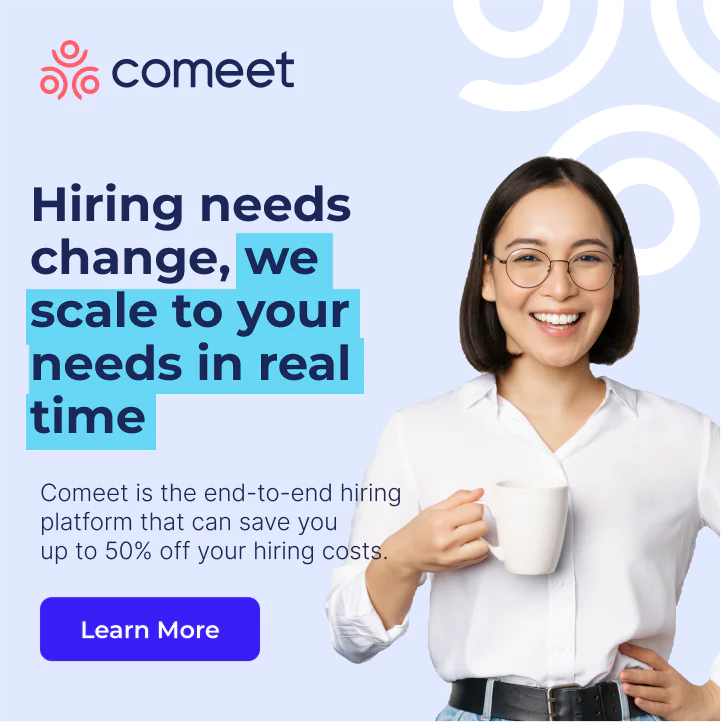As we head into 2023, Applicant Tracking Systems (ATS) solutions are evolving rapidly. From artificial intelligence (AI) to virtual reality (VR), the latest trends in ATS technology are poised to change how HR professionals approach recruitment.
What does this mean for your HR and recruiting departments? It means you’ll want to stay apprised of these developments. Failure to do so can see you missing out on these technological advancements. You may miss chances to improve your recruiting effectiveness and efficiency. Even worse, you may miss out on top candidates.
In this article, we’ll take a look at the key ATS trends to watch in 2023 and explore how they will impact the recruitment process and your role as an HR professional.
What are the key trends in ATS technology to be aware of in 2023?
Recruiting is constantly changing, which is why HR professionals must stay up to date with the latest trends and developments in this arena. Understanding different technological developments ensure you align your efforts with the level of service candidates are expecting.
Below are a few examples of crucial ATS trends you should have on your radar in the near future:
Artificial Intelligence (AI) and Machine Learning (ML)
AI and ML are becoming increasingly common in ATS, with more and more systems incorporating these technologies to automate tasks such as resume screening and candidate matching. This can help HR professionals save time and improve the efficiency of the recruitment process.
Virtual Reality (VR)
VR technology is being integrated into ATS to provide a more immersive candidate experience. This can include virtual tours of the workplace and interactive job simulations. This technology can also be used to conduct virtual interviews and assess candidates’ soft skills in a more natural and realistic setting.
In recent years, the workplace has changed irrevocably. It’s now common to lean on virtual meeting technology more than ever. VR represents a natural evolution in workplace tools. As VR makes its way into the office environment, it will also help shape recruiting in the future.
Chatbots
Chatbots are becoming more sophisticated, and many ATS systems now incorporate them to answer candidates’ questions and guide them through the application process. This can help to improve the candidate experience and reduce the workload for HR professionals.
When it comes to recruiting, quick, transparent, and consistent communication is vital to winning over candidates. Chatbots enable you to prioritize speed and connection. You won’t have to worry about lag times when staying connected with candidates. They’ll be able to reach you fast, even if a live person can’t speak with them when they need a question answered.
Predictive Analytics
Predictive analytics are being used to analyze data from resumes and job applications to identify candidates who are most likely to be a good fit for a particular role. This can help HR professionals to make more informed hiring decisions and improve the overall quality of candidates.
Mobile Optimization
With more and more job seekers using mobile devices to apply for jobs, ATS systems are becoming increasingly mobile-optimized. This can include features such as mobile-responsive design and SMS notifications for candidates.
Applying for a job used to be a long, drawn-out process for job seekers. This is no longer the case for companies prioritizing the candidate experience. Mobile optimization helps make the application process as seamless as possible, which will reflect well on your organization. Mobile optimization is a perfect example of meeting candidates where they are through a mechanism they’re likely to use.
How will these trends impact the recruitment process and the role of HR professionals?
These trends represent seismic shifts in how you can source, recruit, and win over candidates. That’s why it’s essential to understand precisely how they’ll shape the future of recruiting.
The use of AI and ML, for example, will automate many of the tasks that HR professionals currently perform manually, such as resume screening and candidate matching. This will allow HR professionals to focus on more strategic tasks, such as developing recruitment strategies and building relationships with candidates. They’ll be able to apply critical thinking skills as they review resumes of the very finest candidates, with automation weeding out those without the needed qualifications.
VR and chatbots, on the other hand, will improve the candidate experience and make it easier for job seekers to engage with HR professionals and the company. This can attract a wider pool of candidates and improve the quality of the recruitment process. If your candidate’s recruiting experience represents what they can expect when they become an employee, it’s safe to say they’ll value the convenience of VR and chatbot capabilities upon their first engagement with your company.
Predictive analytics will also help HR professionals to make more informed hiring decisions and improve the overall quality of candidates. This can reduce the time and cost of the recruitment process and increase the success rate of hires. Look at data as a tool you can use to improve your decision-making. With predictive analytics, you can shorten the recruiting runway with better-suited candidates.
Mobile optimization will make it easier for job seekers to apply for jobs on the go and allow HR professionals to reach a wider pool of candidates. Again, it’s about improving the candidate experience from day one.
What are the potential benefits and challenges of these trends for HR professionals?
These trends aren’t simply change for the sake of change – they stand to revolutionize how you recruit successfully. The potential benefits of these trends for HR professionals include the following:
- Increased efficiency and productivity, as many tasks will be automated
- Improved candidate experience and engagement, which can help to attract a wider pool of candidates
- More informed hiring decisions and improved quality of candidates
- Increased reach and access to a broader pool of job seekers.
However, some challenges come with these trends. Some of the challenges include the following:
- HR professionals may need to develop new skills to take advantage of the latest ATS technologies
- There may be a learning curve as HR professionals adapt to the new systems and processes
- You’ll need to communicate changes in how you operate to any affected departments so that operations and communications aren’t slowed
Like with any evolution, change requires clear communication and a dedication to new solutions. You can minimize the challenges and reap the benefits with time, commitment, and dialogue between all impacted parties.
How can HR professionals stay up-to-date with the latest ATS trends and technologies?
As HR professionals, staying up-to-date with the latest ATS trends and technologies is essential to ensure that your organization utilizes the best tools available for recruiting and hiring.
But how can you do this? By knowing what communication channels to stay in touch with on a regular basis.
Here are a few ways to stay informed about the ATS trends to watch in 2023:
Attend industry events and conferences
Many conferences and events are dedicated to the latest ATS trends and technologies. Attending these events can provide valuable insights and allow you to network with other HR professionals and ATS experts. You can tap into a wealth of knowledge, network with like-minded professionals, and learn about other technological developments before your competitors.
Follow industry thought leaders
You don’t have to go to conferences to stay informed. Follow experts in the field of ATS on social media and read their blogs to maintain awareness of the latest trends and developments. You can find a lot of great insight from industry leaders – all for free – by identifying the right thought leaders and news outlets. Using sites like Twitter, you can create a customized feed with a steady flow of actionable content you can use.
Try new technologies
Keep an eye out for new ATS products and technologies and consider trying them. This will give you hands-on experience with the latest tools and allow you to make informed decisions about what will work best for your organization. Keep an open mind and try to widen your perspective as much as possible in terms of tools you can use.
Align yourself with professional organizations
Joining professional organizations such as the Society for Human Resource Management (SHRM) and the National Association of Professional Employer Organizations (NAPE) can provide access to a wealth of information and resources on the latest ATS trends. They can also keep you updated on upcoming trends as well as any impacts you can expect from their implementation.
Join online communities
Social media can also put you in touch with groups of people who have the same professional goals as you. Join online communities like LinkedIn groups to connect with other HR professionals and stay informed about the latest ATS trends and technologies.
By following these tips, you will be well-equipped to stay up-to-date with the latest ATS trends and ensure that your organization utilizes the best tools available for recruiting and hiring in 2023.
How can HR professionals prepare for and take advantage of new technology trends in their recruitment process?
HR professionals can prepare for and take advantage of new technology trends in their recruitment process by keeping themselves informed about the latest developments in your field (see ideas listed above). That’s the first step. This includes staying up to date on the latest features and capabilities of ATS software, as well as keeping an eye out for new technologies and tools that are emerging in the market.
One way to take advantage of new technology trends is to actively seek out new tools and technologies to improve the recruitment process. Using those communication channels you’ve set up to stay informed, lean into the adoption of new tech. This starts at the top of your organization – you must have a culture that welcomes change for the sake of improvement.
It’s also crucial for HR professionals to be open to new ways of working and be willing to experiment with new technologies and tools. This means being ready to test new approaches and willing to change their recruitment process if they see that new technology is producing better results. It can be easy to become set in your ways when you’re used to the status quo, but new technology can lead to an even more accessible and effective way of doing things.
Finally, HR professionals should also be prepared to invest in new technologies and tools to support their recruitment process. This may include budgeting for new software or employee training and dedicating resources to implement and manage new technologies. Build a business case for why these tools will help attract the best candidates and, in turn, increase your bottom line. What is the best way to accomplish this? Get the ear of the decision-makers within your organizational chart. Making this argument to your company’s C-suite is bound to impress them.
It’s critical for your HR department to follow current ATS trends
With the fast-paced development of technology, the recruitment process is changing. It’s essential to keep up with the latest advancements to attract and retain top talent. By staying informed, actively seeking out new tools and technologies, being open to new ways of working, experimenting, and investing in new technologies, your HR department can improve the recruitment process and gain a competitive edge in the job market. It’s critical for your HR department to stay on the cutting edge of recruitment by following and tapping into current ATS trends.
By keeping an eye on the top ATS trends to watch in 2023, your HR department can remain ahead of the curve and be prepared to implement new technologies and tools to improve recruitment. Whether using AI-powered recruitment chatbots, virtual reality technology, or other emerging technologies, staying on top of the latest trends will help your HR department win the best candidates for your organization.
Always embrace change and adaptation as it comes along – your company and your candidates will thank you. By remaining mindful of new developments and accepting these trends, you put your company in a better spot to improve its recruitment efforts.





























